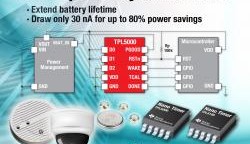Two Nano Power Timers from TI
on

Circuits consume energy when they switch state, clocks and counters are therefore quite costly in terms of battery life for mobile applications. Texas Instruments have addressed this issue with the release of two new timer chips that typically require just 30 nA at 2.5 V.
Both chips use the same basic timing cell made up of a low power clock running at around 64 Hz connected to a programmable frequency divider where a 3-bit code selects the required timing. The TPL5000 is intended to use in interrupt driven applications and can perform a watchdog function, allowing the microcontroller to run in low power sleep mode. Timing periods of 1 to 64 seconds are possible.
The TPL5100 is intended to switch power to a microcontroller for intermittent use in applications such as remote data logging, energy harvesting systems, building automation and low power wireless etc. It provides a MOS_DRV output which can be used to drive an external MOSFET to switch the microcontroller’s supply. Timing periods from 16 to 1024 seconds can be selected.
Both chips can interface with a power management chip to ensure that the microcontroller is not turned on if the supply voltage is marginal.


Discussion (0 comments)